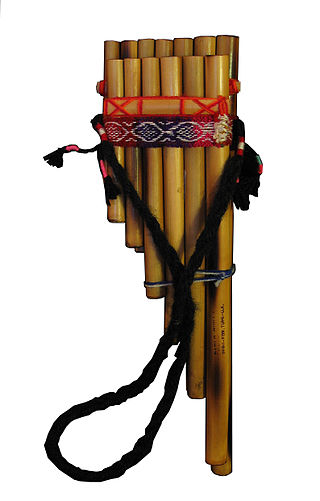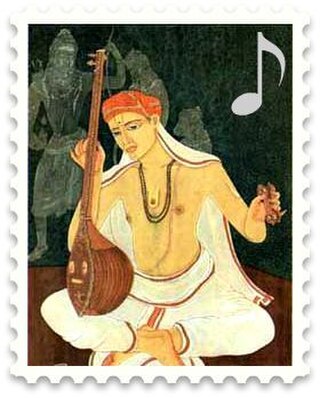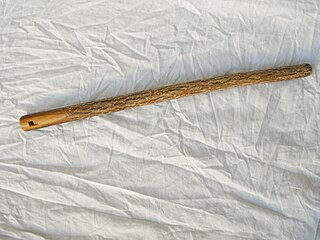
The flute is a member of a family of musical instruments in the woodwind group. Like all woodwinds, flutes are aerophones, producing sound with a vibrating column of air. Unlike woodwind instruments with reeds, a flute produces sound when the player's air flows across an opening. In the Hornbostel–Sachs classification system, flutes are edge-blown aerophones. A musician who plays the flute is called a flautist or flutist.

A pan flute is a musical instrument based on the principle of the closed tube, consisting of multiple pipes of gradually increasing length. Multiple varieties of pan flutes have been popular as folk instruments. The pipes are typically made from bamboo, giant cane, or local reeds. Other materials include wood, plastic, metal and ivory.

The music of Albania is associated with the country of Albania and Albanian communities. Music has a long tradition in the country and is known for its regional diversity, from the Ghegs in the North to the Tosks in the South. It is an integral part of the national identity, strongly influenced by the country's long and turbulent history, which forced Albanians to protect their culture from their overlords by living in rural and remote mountains.

The kaval is a chromatic end-blown oblique flute traditionally played throughout the Balkans and Anatolia. The kaval is primarily associated with mountain shepherds.

The qeleshe, plis, qylaf or kësul is a white brimless felt skull cap traditionally worn by Albanians. It has spread throughout Albanian-inhabited territories, and is today part of the traditional costume of the Albanians. The height and shape of the cap varies region to region.

The end-blown flute is a woodwind instrument played by directing an airstream against the sharp edge of the upper end of a tube. Unlike a recorder or tin whistle, there is not a ducted flue voicing, also known as a fipple. Most rim-blown flutes are "oblique" flutes, being played at an angle to the body's vertical axis. A notched flute is an end-blown flute with a notch on the blowing surface. A lip-valley flute is a type of notched flute.

Music of Jammu and Kashmir reflects a rich musical heritage and cultural legacy of the Indian-administered union territory of Jammu and Kashmir. Two different regions of Jammu and Kashmir consists the Jammu region and Kashmir Valley. Music of Kashmir Valley has influences of Central Asian music while music from Jammu region is similar to that of other regions of North India.
The Western concert flute is a family of transverse (side-blown) woodwind instruments made of metal or wood. It is the most common variant of the flute. A musician who plays the flute is called a “flautist” in British English, a “flutist” in American English.
Perëndi is an Albanian noun for God, deity, sky and heaven. It is used capitalized to refer to the Supreme Being, and uncapitalized for "deity", "sky" and "heaven".
The atenteben(atɛntɛbɛn) is a bamboo flute from Ghana. It is played vertically, like the European recorder, and, like the recorder, can be played diatonically as well as chromatically. Although originally used as a traditional instrument, beginning in the 20th century it has also been used in contemporary and classical music. Several players have attained high levels of virtuosity and are able to play Western as well as African music on the instrument.

The fujara is a large wind instrument of the tabor pipe class. It originated in central Slovakia as a sophisticated folk shepherd's overtone fipple flute of unique design in the contrabass range.

The frula, also known as svirala (свирала) or jedinka, is a musical instrument which resembles a medium sized flute, traditionally played in rural Southeast Europe, primarily South Slavic countries. It is an end-blown aerophone with six holes, typically made of wood. The frula is a traditional instrument of South Slavic shepherds, who would play while tending their flocks.

Hoti is a historical Albanian tribe (fis) and sub-region of Malësia, a divided area located in northern Albania and southern Montenegro. Its geography is mostly mountainous, but some of its villages are on flat terrain near the banks of Lake of Shkodër.

Albanian folk beliefs and mythological stories comprise the beliefs expressed in the customs, rituals, myths, legends and tales of the Albanian people. The elements of Albanian mythology are of ancient Paleo-Balkanic origin and almost all of them are pagan. Albanian folklore evolved over the centuries in a relatively isolated tribal culture and society. Albanian folk tales and legends have been orally transmitted down the generations and are still very much alive in the mountainous regions of Albania, Kosovo, western North Macedonia, Montenegro and South Serbia and among the Arbëreshë in Italy and the Arvanites in Greece.

The koncovka is a Slovak duct-blown overtone fipple flute without finger holes, traditionally played by shepherds. The koncovka is played by closing and opening the bottom hole of the flute. By increasing the air speed, two different harmonic series of notes can be played with the end either open or closed. Traditional koncovka melodies use the partial Lydian scale available on this instrument.

Svirel is a Slavic woodwind instrument of the end-blown flute type traditionally used in Russia, Belarus, and Ukraine. It is a parallel-bore flute. The six-hole versions are similar to the tin whistle; the ten-hole versions are fully chromatic.

The Bulgarian dvoyanka is a double flute made of a single piece of wood, with six sound holes on one side.

Kângë majekrahi alternatively kângë malësorçe is a type of "call to action" monophonic male singing or chanting originating from the Northern Albanian mountains among the Albanian Gheg population.

Zojz is a sky and lightning god in Albanian pagan mythology. Regarded as the chief god and the highest of all gods, traces of his worship survived in northern Albania until the early 20th century, and in some forms still continue today.

The vatër is the domestic hearth in Albanian folklore. The fire of the domestic hearth, zjarri i vatrës, holds divine attributes in folk beliefs, being considered the sustainer of the continuity between the world of the living and that of the dead, and ensuring the continuity of the tribe (fis) from generation to generation.














